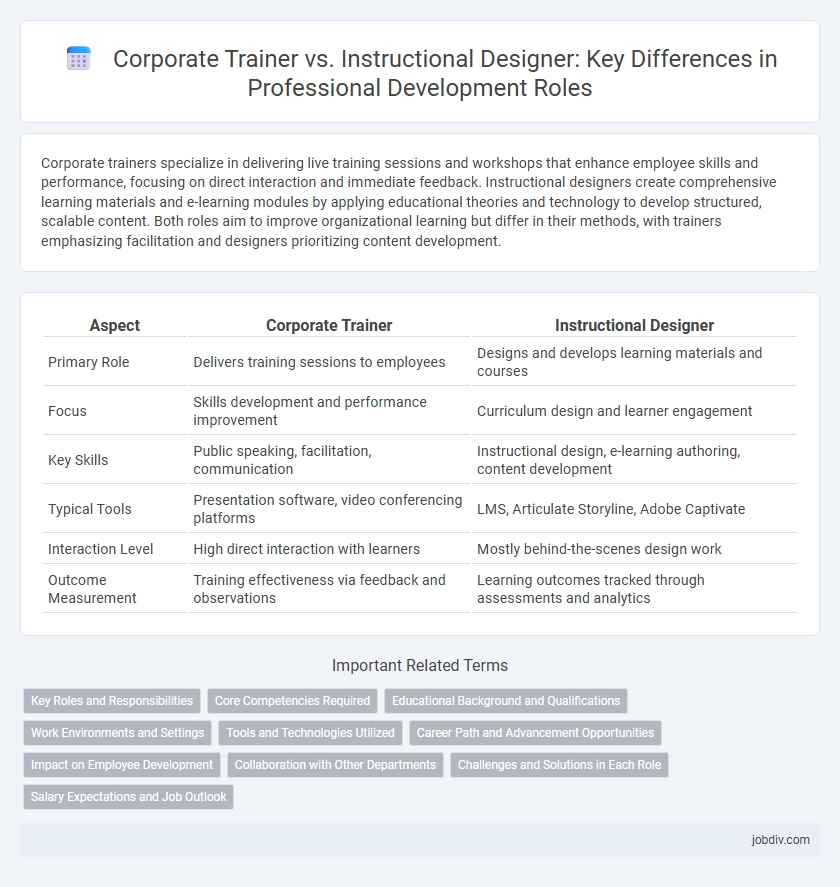Corporate trainers specialize in delivering live training sessions and workshops that enhance employee skills and performance, focusing on direct interaction and immediate feedback. Instructional designers create comprehensive learning materials and e-learning modules by applying educational theories and technology to develop structured, scalable content. Both roles aim to improve organizational learning but differ in their methods, with trainers emphasizing facilitation and designers prioritizing content development.
Table of Comparison
| Aspect | Corporate Trainer | Instructional Designer |
|---|---|---|
| Primary Role | Delivers training sessions to employees | Designs and develops learning materials and courses |
| Focus | Skills development and performance improvement | Curriculum design and learner engagement |
| Key Skills | Public speaking, facilitation, communication | Instructional design, e-learning authoring, content development |
| Typical Tools | Presentation software, video conferencing platforms | LMS, Articulate Storyline, Adobe Captivate |
| Interaction Level | High direct interaction with learners | Mostly behind-the-scenes design work |
| Outcome Measurement | Training effectiveness via feedback and observations | Learning outcomes tracked through assessments and analytics |
Key Roles and Responsibilities
Corporate trainers deliver live and virtual training sessions, focusing on skill development and employee engagement within organizations. Instructional designers create structured learning materials, using instructional technology and pedagogical principles to develop effective e-learning courses and training programs. Both roles collaborate to enhance workforce performance but differ in their direct interaction with learners and content creation responsibilities.
Core Competencies Required
Corporate trainers excel in communication, presentation skills, and real-time learner engagement, essential for delivering effective training sessions and facilitating employee development. Instructional designers require expertise in curriculum design, e-learning software, and data analysis to create structured, technology-driven training programs tailored to organizational needs. Both roles demand a strong understanding of adult learning principles and industry-specific knowledge to optimize workforce performance.
Educational Background and Qualifications
Corporate trainers typically hold degrees in education, human resources, or business administration, alongside certifications such as Certified Professional in Learning and Performance (CPLP) or Association for Talent Development (ATD) credentials. Instructional designers often possess backgrounds in instructional technology, educational psychology, or curriculum design, complemented by expertise in e-learning software and Learning Management Systems (LMS). Both roles benefit from advanced degrees and specialized training to enhance their skills in adult learning theories and content development methodologies.
Work Environments and Settings
Corporate trainers primarily operate within dynamic, interactive environments such as conference rooms, training centers, or onsite corporate facilities, facilitating live workshops and hands-on sessions to enhance employee skills. Instructional designers often work in more isolated, office-based or remote settings, utilizing digital tools and software to develop comprehensive training materials and e-learning modules tailored to organizational needs. Both roles require collaboration with subject matter experts but differ in their work environments, with trainers emphasizing face-to-face engagement and designers focusing on content creation and instructional strategies.
Tools and Technologies Utilized
Corporate trainers utilize interactive tools such as Learning Management Systems (LMS), webinar platforms like Zoom or Microsoft Teams, and assessment software to deliver and evaluate training sessions effectively. Instructional designers rely on authoring tools like Articulate Storyline, Adobe Captivate, and Camtasia to create engaging, multimedia-rich e-learning content tailored to specific learning objectives. Both roles incorporate analytics platforms to assess learner progress, but instructional designers emphasize content development tools while corporate trainers focus on real-time delivery and participant engagement technologies.
Career Path and Advancement Opportunities
Corporate trainers typically advance by gaining expertise in specific industries or training methodologies, progressing into roles such as Training Manager or Learning and Development Director. Instructional designers often grow by mastering e-learning technologies and curriculum development, leading to positions like Senior Instructional Designer or Director of Instructional Design. Both career paths offer opportunities in leadership and specialization, with trainers focusing on delivery and engagement, while instructional designers emphasize content creation and technology integration.
Impact on Employee Development
Corporate trainers directly enhance employee skills through interactive workshops and real-time feedback, fostering immediate application and engagement. Instructional designers create structured learning programs that ensure consistent knowledge transfer and scalable training solutions across the organization. Together, they drive comprehensive employee development by combining tailored content delivery with strategic instructional design.
Collaboration with Other Departments
Corporate trainers collaborate closely with human resources and management to align training programs with organizational goals, while instructional designers work with subject matter experts and marketing teams to create tailored learning materials. Both roles require strong communication skills to ensure content accuracy and relevance across departments. Effective interdepartmental collaboration enhances the overall impact of employee development initiatives and drives business performance.
Challenges and Solutions in Each Role
Corporate trainers face challenges in engaging diverse learner groups and adapting content for varied skill levels, often relying on interactive workshops and real-time feedback to enhance learning effectiveness. Instructional designers struggle with translating complex subject matter into accessible, scalable e-learning modules, employing user-centered design and iterative testing to improve content clarity and learner retention. Both roles require continuous collaboration with subject matter experts and leveraging technology to address evolving organizational training needs effectively.
Salary Expectations and Job Outlook
Corporate trainers typically earn an average salary ranging from $55,000 to $85,000 annually, with job growth projected at 7% over the next decade due to increased demand for workforce development. Instructional designers command a higher average salary, between $65,000 and $95,000 per year, driven by the expanding need for e-learning and digital curriculum design, with job outlook growth estimated at 8%. Both roles offer strong career prospects, but instructional designers tend to achieve higher compensation linked to specialized technical skills and evolving educational technologies.
Corporate Trainer vs Instructional Designer Infographic

 jobdiv.com
jobdiv.com